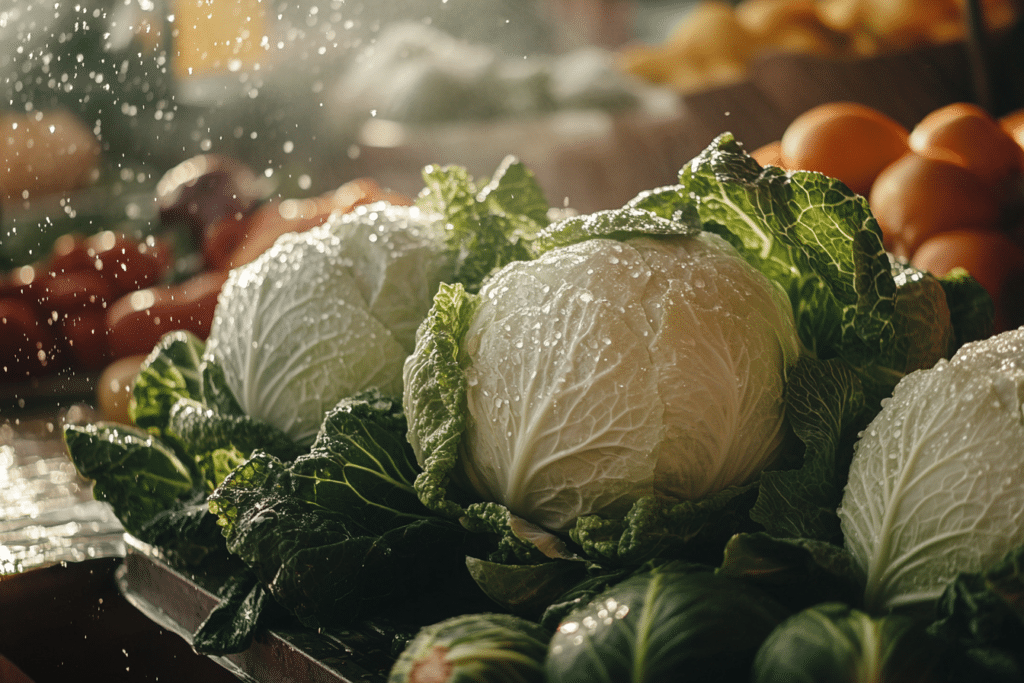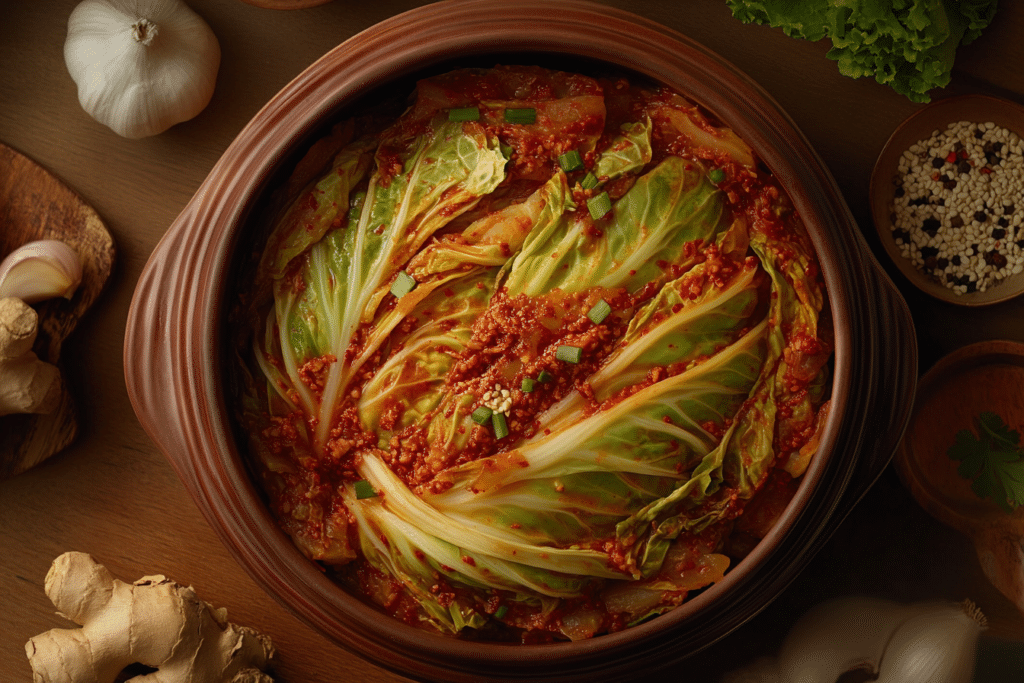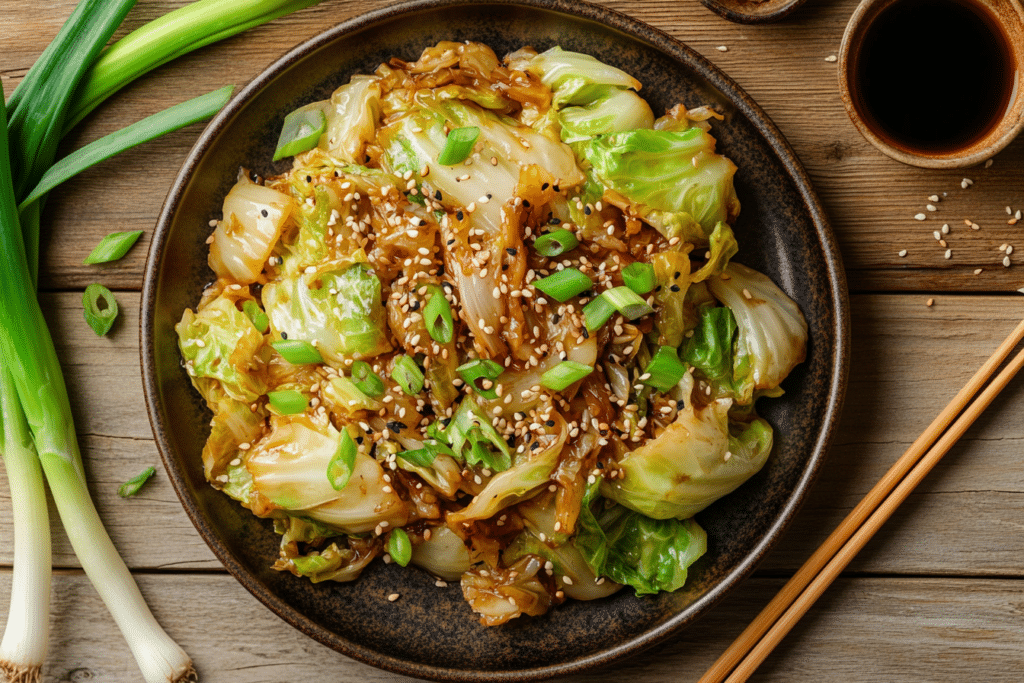1. Introduction
Napa cabbage recipes are a delightful way to enjoy this versatile vegetable, known for its tender leaves and mild flavor. From traditional dishes like kimchi to modern creations like wraps and slaws, these recipes showcase the endless possibilities of napa cabbage while delivering health benefits and culinary excitement. This guide dives into the many ways napa cabbage can elevate your meals. Alongside its culinary potential, napa cabbage is a nutritional powerhouse, offering vitamins and antioxidants that contribute to overall well-being. By the end of this article, you’ll have a variety of recipes and tips to make the most of this humble vegetable.
2. What is Napa Cabbage?
2.1 Origin and History
Napa cabbage, often referred to as Chinese cabbage, originated in East Asia. It is a key component in traditional dishes like kimchi and has been cultivated for centuries for its unique flavor and texture. Unlike regular cabbage, napa cabbage has crinkled, soft leaves that make it ideal for a wide range of dishes.
2.2 Description and Characteristics
Napa cabbage is easily distinguishable by its oblong shape and pale green, tender leaves. Its flavor is milder compared to green cabbage, with a slight sweetness that enhances dishes. The vegetable’s crunchy ribs contrast well with its leafy sections, creating a delightful texture in recipes.
2.3 How Napa Cabbage Differs from Other Types of Cabbage
While both napa cabbage and green cabbage belong to the brassica family, their culinary applications differ significantly. Green cabbage has a tougher texture and a more pungent taste, making it better suited for slow-cooking. Napa cabbage, on the other hand, shines in dishes that require quick cooking or fresh preparations.
3. Health Benefits of Napa Cabbage
3.1 Nutritional Profile
Napa cabbage is a low-calorie vegetable packed with essential nutrients. For other healthy recipes, check out the Ninja Creami Recipes Guide here. It is an excellent source of Vitamin C, Vitamin K, and folate. These nutrients contribute to immune system support and improved bone health. Additionally, napa cabbage contains trace amounts of calcium and iron, making it a valuable addition to any diet.
3.2 Role in Digestive Health
Thanks to its high fiber content, napa cabbage aids digestion and promotes a healthy gut microbiome. Incorporating napa cabbage into your meals can help prevent constipation and support overall gut health.
3.3 Antioxidant Properties
Napa cabbage contains plant compounds like glucosinolates and polyphenols, which have antioxidant properties. These compounds help combat oxidative stress and may reduce the risk of chronic diseases such as heart disease and certain cancers.
4. Tips for Selecting and Storing Napa Cabbage
4.1 How to Choose Fresh Napa Cabbage

When selecting napa cabbage, look for firm heads with crisp, unblemished leaves. The color should be a vibrant pale green or yellowish-white, and the leaves should feel tender but not wilted. Avoid any cabbage with brown spots or a sour smell, as these are signs of spoilage.
4.2 Best Practices for Storing Napa Cabbage
To maintain freshness, store napa cabbage in a sealed plastic bag in the refrigerator’s crisper drawer. This prevents moisture loss and keeps the leaves crunchy for up to two weeks.
4.3 Shelf Life and Signs of Spoilage
Napa cabbage can last 10-14 days when stored properly. However, if the leaves become slimy or emit a strong, unpleasant odor, it’s time to discard it.
5. Culinary Uses of Napa Cabbage
5.1 Traditional Dishes Featuring Napa Cabbage
Napa cabbage is a star ingredient in traditional dishes like Korean kimchi, Japanese hot pot (nabe), and Chinese dumplings. Its mild flavor and tender texture allow it to soak up the flavors of the accompanying ingredients.
5.2 Versatility in Modern Recipes
Modern cooks have embraced napa cabbage in creative ways, from refreshing slaws to grilled sides. It is an excellent alternative to lettuce in wraps or a crunchy addition to tacos.
5.3 Pairing Napa Cabbage with Other Ingredients
Napa cabbage pairs well with garlic, ginger, soy sauce, and sesame oil. For another versatile ingredient, explore the Lion’s Mane Mushroom Recipe here. For soups, it complements proteins like chicken and tofu. You can explore additional pairing ideas here. Its mildness makes it a great partner for bold, spicy, or tangy flavors.
6. 10 Must-Try Napa Cabbage Recipes
6.1 Classic Napa Cabbage Kimchi

Kimchi, a fermented Korean dish, relies heavily on napa cabbage for its iconic texture and flavor. Learn more about traditional kimchi preparation here. To prepare, the cabbage is salted and combined with a spicy paste made of chili, garlic, and ginger. After fermentation, it delivers a tangy and spicy punch that pairs well with rice and stews.
6.2 Napa Cabbage Stir-Fry with Garlic and Soy Sauce

A quick and simple recipe, this stir-fry highlights napa cabbage’s natural sweetness. Sauté the cabbage with garlic and a splash of soy sauce for a dish that’s ready in minutes.
6.3 Napa Cabbage Salad with Sesame Dressing
This refreshing salad combines shredded napa cabbage with a nutty sesame dressing. Add carrots, scallions, and toasted sesame seeds for extra texture and flavor.
6.4 Stuffed Napa Cabbage Rolls in Tomato Sauce
For a hearty main course, napa cabbage leaves serve as a perfect wrap for a filling of ground meat, rice, and spices. Simmer the stuffed rolls in a rich tomato sauce until tender. This recipe is a healthy twist on traditional cabbage rolls, with a softer texture and a sweeter flavor.
6.5 Napa Cabbage Soup with Tofu and Mushrooms
This comforting soup is a great way to enjoy napa cabbage during colder months. Combine sliced cabbage with tofu, mushrooms, and a flavorful broth. A touch of ginger and soy sauce adds warmth and depth.
6.6 Grilled Napa Cabbage with Herb Butter
Grilling transforms napa cabbage into a smoky, charred delicacy. Brush halved cabbage heads with herb butter and grill until the edges are slightly crispy. This side dish is perfect for summer barbecues.
6.7 Napa Cabbage Slaw with Apple and Carrots
This crunchy slaw combines shredded napa cabbage with julienned apples and carrots. Toss with a tangy vinaigrette for a refreshing dish that’s ideal for potlucks or picnics.
6.8 Crispy Napa Cabbage Tempura
Tempura-battered napa cabbage creates a unique and crispy appetizer. Dip cabbage leaves into a light batter, fry until golden, and serve with a soy-based dipping sauce.
6.9 Napa Cabbage Dumplings
These bite-sized delights feature napa cabbage finely chopped and mixed with ground meat or tofu. The mixture is wrapped in dough and steamed or fried for a flavorful appetizer or main dish.
6.10 Vegan Napa Cabbage Wraps with Spicy Peanut Sauce
For a healthy, plant-based option, use napa cabbage leaves as wraps. Fill them with a mixture of quinoa, shredded carrots, and edamame. Drizzle with a spicy peanut sauce for a satisfying meal.
7. Creative Twists on Napa Cabbage Recipes
7.1 Napa Cabbage Tacos
Napa cabbage can be used as an alternative to lettuce in wraps or tacos. Pair it with a perfect burger sauce recipe here for a delightful twist. Fill them with seasoned meat, beans, or veggies for a fresh take on tacos.
7.2 Napa Cabbage Pizza Topping
Shredded napa cabbage adds a unique crunch to pizzas. Toss the cabbage in olive oil and season with garlic before layering it on your pizza crust alongside your favorite toppings.
7.3 Napa Cabbage Casserole
Incorporate napa cabbage into a creamy casserole with layers of cheese, béchamel sauce, and breadcrumbs. Bake until golden for a comforting dish that highlights the cabbage’s tender texture.
8. Tips for Cooking Napa Cabbage
8.1 Preparation Techniques
- Chopping: Slice the cabbage into thin ribbons for salads or stir-fries.
- Blanching: Blanch the leaves in boiling water for 1-2 minutes to reduce any slight bitterness. For detailed instructions, refer to this blanching guide here
- Fermenting: Use napa cabbage as a base for homemade kimchi or sauerkraut.
8.2 Dos and Don’ts
- Do: Rinse the leaves thoroughly to remove dirt and grit.
- Don’t: Overcook napa cabbage, as it can lose its crunch and become mushy.
9. Frequently Asked Questions (FAQs)
9.1 What is the best way to eat napa cabbage?
The best way to enjoy napa cabbage depends on your preference. It can be eaten raw in salads or slaws, stir-fried with garlic and soy sauce, or fermented into kimchi for a tangy flavor. Its mild taste makes it a versatile ingredient in both hot and cold dishes.
9.2 How do you remove bitterness from napa cabbage?
Napa cabbage is generally less bitter than green cabbage, but any slight bitterness can be reduced by blanching the leaves in boiling water for 1-2 minutes. Pairing it with sweet or tangy sauces also balances the flavors.
9.3 Is napa cabbage healthier than regular cabbage?
Both napa cabbage and regular cabbage are healthy, but napa cabbage has fewer calories and is slightly richer in Vitamin A and calcium. It also has a milder taste, making it more palatable for those who find regular cabbage too pungent.
9.4 Is bok choy the same as napa cabbage?
No, bok choy and napa cabbage are different vegetables. While both are part of the Brassica family, bok choy has darker green leaves and white stems, while napa cabbage has pale green leaves and a more compact, oblong shape. Their flavors and uses also differ, with bok choy being more suitable for stir-fries and napa cabbage for wraps and soups.
10. Conclusion
Napa cabbage is a culinary gem that brings both flavor and nutrition to the table. Its tender leaves and mild taste make it an incredibly versatile ingredient in a variety of dishes, from traditional kimchi to modern vegan wraps. Packed with essential vitamins, fiber, and antioxidants, it supports overall health while elevating meals with its unique texture and adaptability.
Whether you’re a seasoned chef or a home cook looking for inspiration, napa cabbage deserves a place in your kitchen. Experiment with the recipes and tips provided in this guide, and you’ll discover how this humble vegetable can transform your cooking.
Let napa cabbage become your next go-to ingredient—share your favorite recipes and tips with others, and celebrate the endless possibilities it offers!
